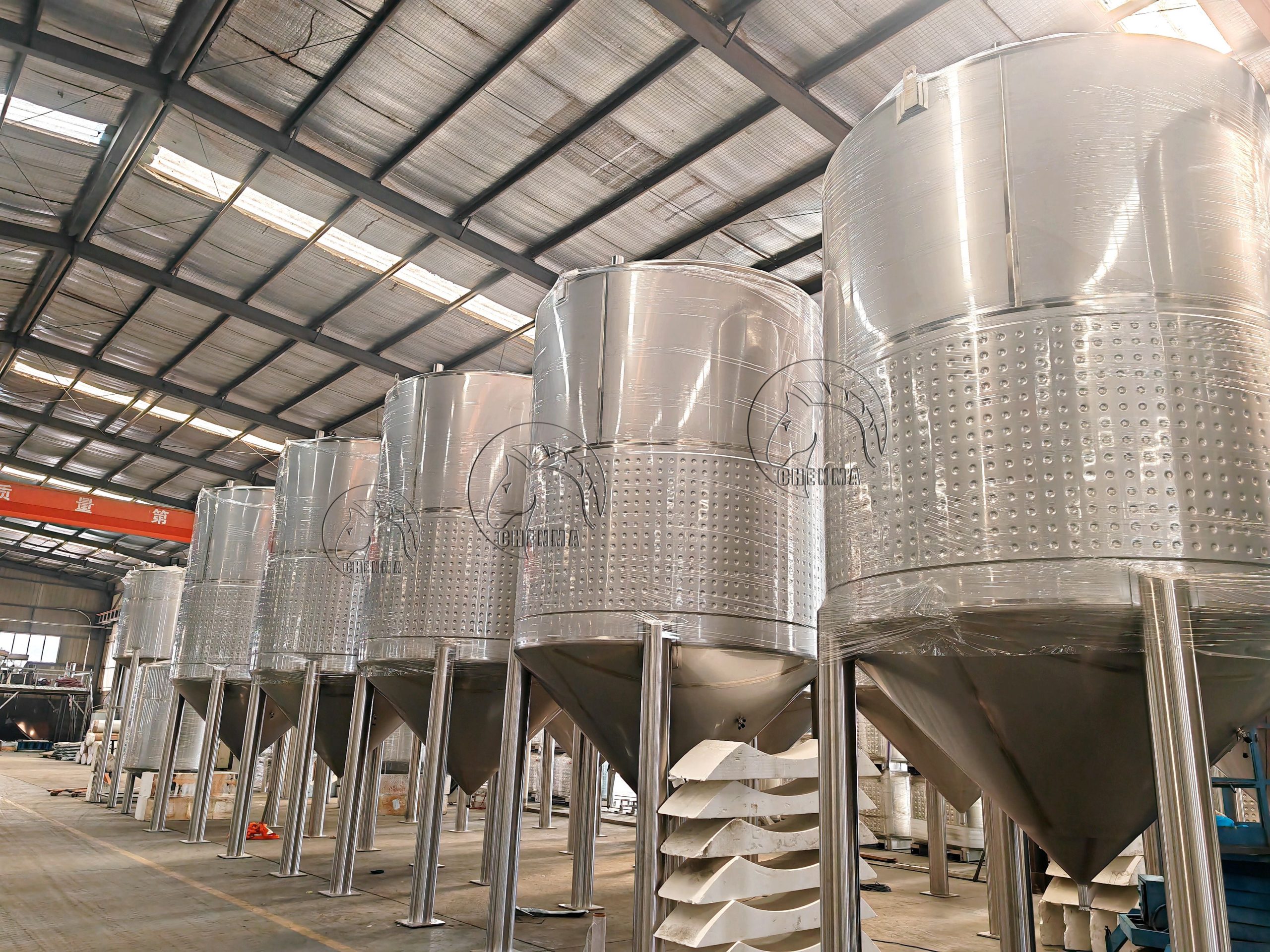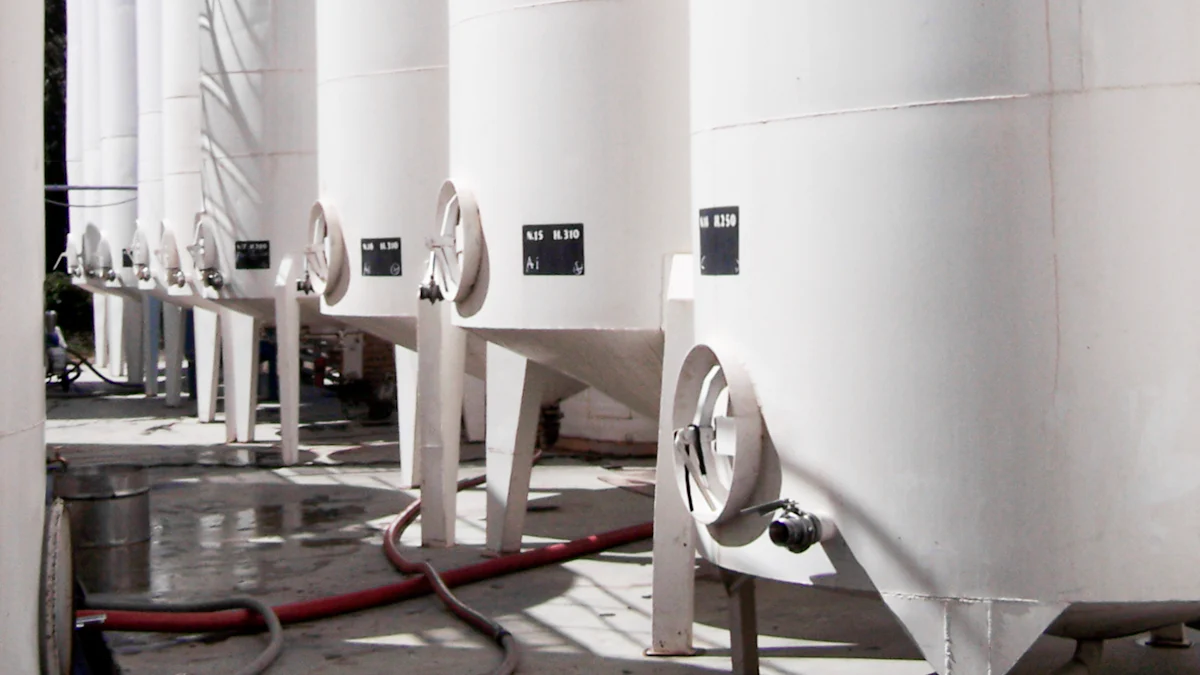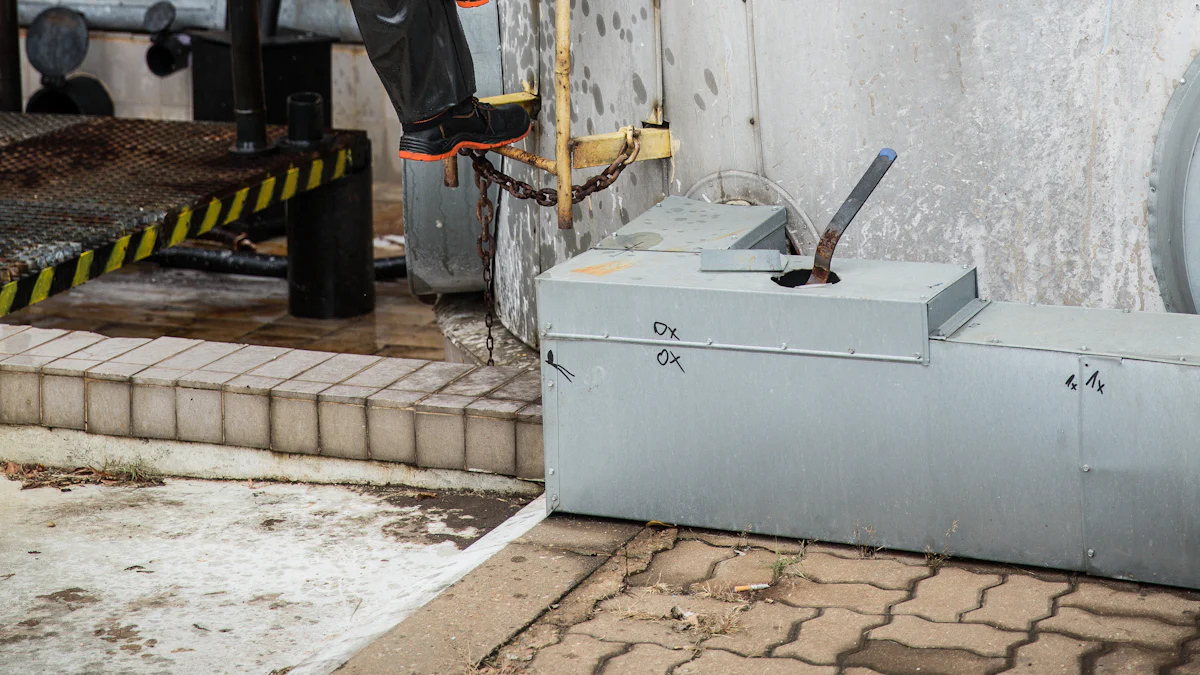
Proper maintenance of your chemical mixer tank is essential for ensuring safety, efficiency, and long-lasting efficiency in your operations. Neglecting upkeep can lead to serious risks, including contamination, equipment failure, and hazardous working conditions. Routine care helps you avoid costly repairs and unexpected downtime. By inspecting components regularly and addressing wear early, you maintain operational stability and prevent disruptions. Consistent cleaning also ensures that residues or unwanted reactions don’t compromise the tank’s performance. A well-maintained mixer not only supports smooth processes but also extends the lifespan of your equipment.
Routine Inspections for Chemical Mixer Tanks
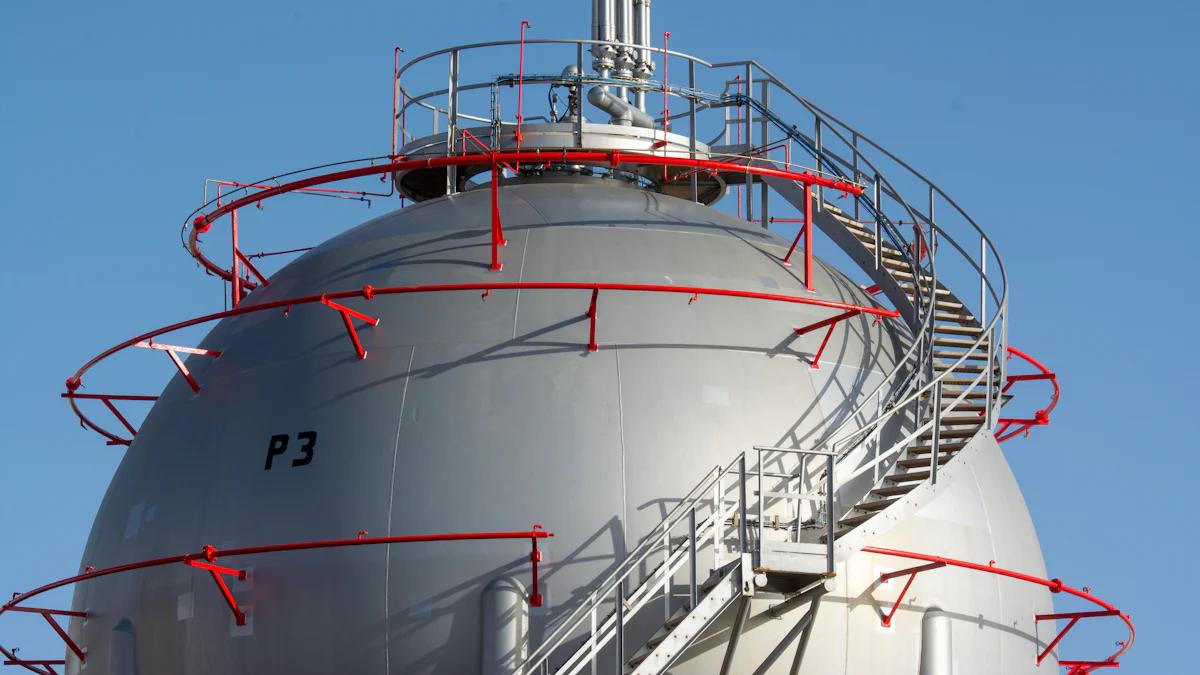
Routine inspections are the backbone of effective maintenance for chemical mixer tanks. By identifying potential issues early, you can prevent costly repairs, ensure operational safety, and extend the lifespan of your equipment. Neglecting inspections increases the risk of leaks, contamination, and even workplace accidents. A proactive approach keeps your tanks in optimal condition and safeguards your operations.
Conducting Visual Checks
Visual checks are a simple yet powerful way to detect early signs of damage or wear. During these inspections, focus on the following:
- Inspect for visible signs of wear, cracks, or damage. Examine the tank’s surface carefully. Cracks or dents can compromise the structural integrity of the tank and lead to leaks or failures.
- Check for leaks around seals, gaskets, and connections. Leaks often indicate worn-out components or improper sealing. Addressing these issues promptly prevents chemical loss and contamination.
- Look for residue buildup or discoloration indicating contamination. Residue can signal improper cleaning or chemical reactions within the tank. Contamination not only affects product quality but also poses safety risks.
Tip: Regular inspection of seals and connections ensures that minor leaks don’t escalate into major problems. Early detection saves time and money.
Identifying Wear and Tear
Wear and tear are inevitable in any mechanical system, but routine inspections help you manage them effectively. Pay attention to these key areas:
- Monitor moving parts for excessive wear. Agitators, mixers, and other components experience constant motion. Excessive wear can lead to inefficiencies or breakdowns. Regular lubrication and adjustments keep these parts functioning smoothly.
- Check for misalignment in agitators or mixers. Misaligned components can cause uneven mixing, increased energy consumption, and accelerated wear. Ensure proper alignment during every inspection.
- Document and address abnormalities promptly. Keep a detailed record of any irregularities you notice. This documentation helps you track recurring issues and plan maintenance activities more effectively.
Did you know? Tanks with regular inspections are less likely to experience catastrophic failures compared to those without. Early detection of wear reduces repair costs and minimizes downtime.
Routine inspections also provide an opportunity to calibrate temperature controls. Accurate temperature regulation is critical for maintaining chemical stability and ensuring consistent mixing performance. Make it a habit to check and calibrate temperature controls during every inspection.
By incorporating these practices into your maintenance routine, you can ensure that your chemical mixer tanks remain reliable and efficient. Regular inspection not only protects your investment but also enhances workplace safety and operational productivity.
Thorough Cleaning Practices
Maintaining the cleanliness of your chemical mixer tank is a cornerstone of effective cleaning and maintenance. A well-executed cleaning routine prevents residue buildup, cross-contamination, and potential damage to your equipment. By adopting thorough cleaning practices, you ensure the tank operates efficiently and maintains its structural integrity over time.
Choosing Compatible Cleaning Agents
Selecting the right cleaning agents is critical for preserving the tank’s material and ensuring safe operations. Not all cleaning solutions are suitable for every tank or chemical mixture. To make the best choice:
- Use cleaning agents suitable for the tank material and chemicals being mixed. Stainless steel, a common material for tanks, pairs well with agents like caustic (sodium hydroxide) for removing organic residues. However, always confirm compatibility to avoid unintended reactions.
- Avoid harsh chemicals that could damage the tank lining. Corrosive agents, if left unchecked, can deteriorate the tank’s surface. For example, while caustic solutions are effective, prolonged exposure may harm the tank. Neutralizing agents like phosphoric acid can mitigate this risk.
Pro Tip: Consult the manufacturer’s guidelines for recommended cleaning solutions. This ensures you use products that align with the tank’s material and the chemicals it processes.
Disassembly for Deep Cleaning
Deep cleaning requires more than surface-level efforts. Disassembling key components allows you to access areas where residues often accumulate. Follow these steps for effective disassembly:
- Safely disassemble components like agitators and seals for thorough cleaning. Agitators and seals are prone to residue buildup due to their constant contact with chemicals. Removing these parts ensures no hidden contaminants remain.
- Follow proper reassembly procedures to avoid misalignment or damage. After cleaning, reassemble the components carefully. Misaligned agitators can lead to uneven mixing and increased wear on the tank.
Safety Reminder: Always wear personal protective equipment (PPE) when handling disassembled parts, especially if they’ve been exposed to hazardous chemicals.
Establishing a Cleaning Schedule
A consistent cleaning schedule is essential for preventative mixer maintenance. It helps you address residue buildup before it becomes a problem. To create an effective schedule:
- Develop a cleaning schedule based on tank usage and the chemicals involved. Tanks used frequently or for mixing reactive substances require more frequent cleaning. For example, after processing highly corrosive chemicals, immediate cleaning is necessary to prevent damage.
- Perform additional cleanings after mixing corrosive or reactive substances. These substances can leave residues that compromise the tank’s performance and safety. Prompt cleaning minimizes risks and extends the tank’s lifespan.
Did You Know? Drying the tank thoroughly after cleaning, using methods like nitrogen or dry air purging, prevents moisture-related issues such as corrosion or microbial growth.
By implementing these thorough cleaning practices, you not only maintain the tank’s efficiency but also reduce the likelihood of costly repairs. Consistent cleaning and maintenance ensure your mixer remains reliable, safe, and ready for operation.
Component Maintenance Tips
Proper care of your chemical mixer tank components ensures smooth operations and prevents costly breakdowns. Neglecting these parts can lead to leaks, contamination, and even environmental hazards. By following these maintenance tips, you can keep your equipment in top condition and extend its lifespan.
Inspecting and Replacing Seals and Gaskets
Seals and gaskets play a critical role in preventing leaks and maintaining the integrity of your mixer. Regular maintenance of these components is essential to avoid operational disruptions.
- Regularly check seals and gaskets for wear, cracks, or leaks. Over time, exposure to chemicals and constant use can degrade these parts. Inspect them during every scheduled maintenance session to identify early signs of damage. For example, cracks in rotating seals can lead to fluid leakage, which may escalate into significant issues if left unaddressed.
- Replace damaged components promptly to prevent leaks or contamination. Delaying replacement increases the risk of chemical spills, which can harm the environment and compromise workplace safety. The 1988 Ashland Oil Spill serves as a reminder of how small leaks can lead to catastrophic outcomes. Swift action minimizes risks and ensures uninterrupted operations.
Pro Tip: Keep spare seals and gaskets on hand to reduce downtime during replacements. Always use manufacturer-approved parts to maintain compatibility and performance.
Lubrication and Alignment
Moving parts like agitators and mixers require regular maintenance to function efficiently. Proper lubrication and alignment are key to preventing wear and ensuring consistent performance.
- Lubricate moving parts as per manufacturer recommendations. Friction from constant motion can cause components to wear out prematurely. Apply the recommended lubricant at specified intervals to reduce friction and extend the life of your mixer. This simple step also improves energy efficiency by reducing resistance during operation.
- Ensure proper alignment of agitators and mixers to prevent uneven wear. Misaligned components can lead to uneven mixing, increased energy consumption, and accelerated wear. During inspections, check alignment and make adjustments as needed. Improper alignment has been linked to seal failures in pumps, which can result in costly repairs and downtime.
Did You Know? A well-maintained mixer not only reduces wear but also enhances product quality by ensuring uniform mixing. Adding alignment checks to your mixer maintenance checklist helps you achieve consistent results.
Regular maintenance of seals, gaskets, and moving parts protects your investment and ensures safe operations. By incorporating these additional mixer maintenance tips into your routine, you can prevent leaks, reduce wear, and maintain the reliability of your equipment.
Preventing and Addressing Corrosion
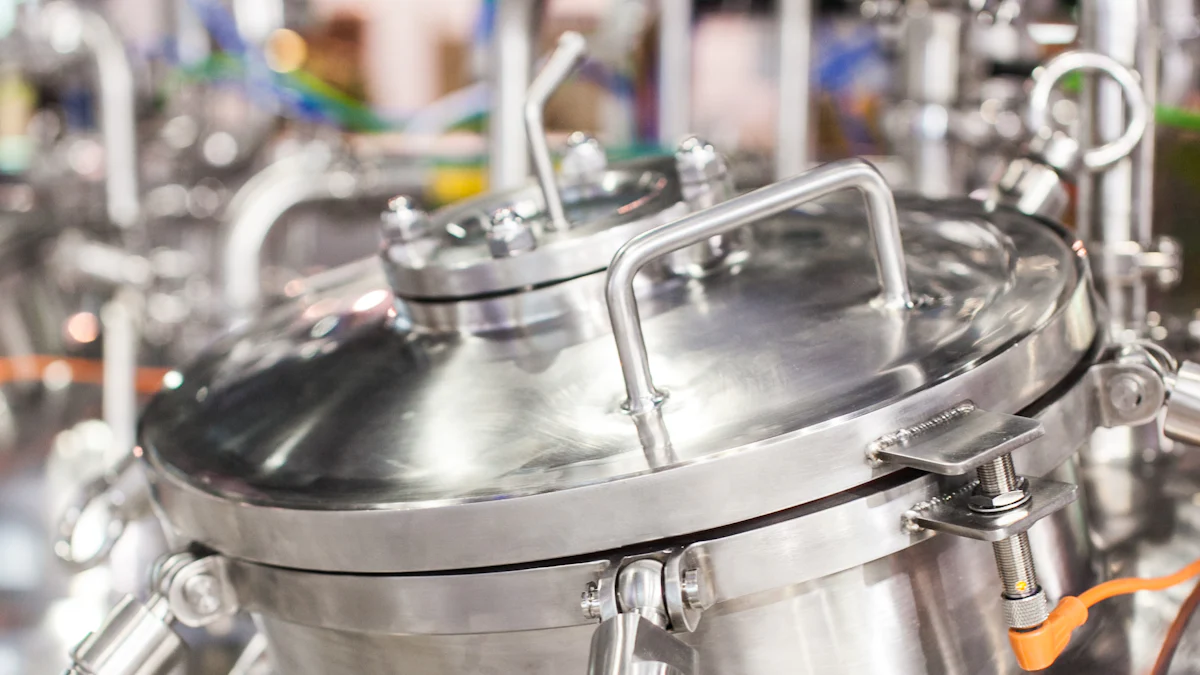
Corrosion poses a significant threat to the integrity and performance of your chemical mixer tank. Without proper attention, it can lead to structural damage, contamination, and costly repairs. By implementing preventive measures and addressing corrosion promptly, you can ensure the longevity and safety of your equipment.
Regular Corrosion Inspections
Routine inspections are essential for identifying early signs of corrosion. These checks help you maintain the structural integrity of your tank and prevent minor issues from escalating into major problems.
- Inspect the tank interior and exterior for rust or corrosion. Examine all surfaces, including hard-to-reach areas, for any discoloration, pitting, or flaking. These are common indicators of corrosion that require immediate attention.
- Pay special attention to weld seams and areas exposed to harsh chemicals. Weld seams are particularly vulnerable due to their exposure to high temperatures during manufacturing. Chemicals with corrosive properties can accelerate damage in these areas.
Pro Tip: Use nondestructive testing methods, such as ultrasonic or magnetic particle testing, to detect hidden corrosion that may not be visible during a visual inspection. This approach ensures a thorough evaluation of your tank’s condition.
Applying Protective Coatings
Protective coatings act as a barrier between the tank’s surface and corrosive elements. Applying these coatings effectively reduces the risk of corrosion and extends the lifespan of your equipment.
- Use corrosion-resistant coatings or linings to protect the tank. Materials like epoxy or polyurethane coatings provide excellent resistance against chemical reactions and environmental factors. Stainless steel tanks, for instance, benefit greatly from these protective layers.
- Reapply coatings as needed based on wear and exposure. Over time, coatings may degrade due to constant contact with chemicals or physical abrasion. Regularly assess the condition of the coating and reapply it when necessary to maintain optimal protection.
Did You Know? Studies have shown that quality coatings applied during manufacturing significantly reduce maintenance needs and improve tank durability. This proactive step minimizes long-term costs and ensures reliable performance.
Addressing Corrosion Damage
When corrosion occurs, addressing it promptly is crucial to prevent further deterioration. Taking immediate action safeguards your tank’s structural integrity and ensures safe operations.
- Remove rust or corrosion promptly using appropriate methods. Mechanical methods, such as wire brushing or sandblasting, effectively eliminate surface rust. For more severe cases, chemical treatments like rust converters can neutralize corrosion and prepare the surface for recoating.
- Repair or replace damaged sections to maintain structural integrity. If corrosion has caused significant damage, consider repairing the affected areas through welding or patching. In extreme cases, replacing the damaged section may be necessary to ensure the tank remains safe and functional.
Safety Reminder: Always follow proper safety protocols when handling corrosive chemicals or performing repairs. Use personal protective equipment (PPE) and consult professionals for complex repairs.
By incorporating regular inspections, protective coatings, and timely repairs into your maintenance routine, you can effectively address corrosion and prolong the life of your chemical mixer tank. These practices not only protect your investment but also enhance operational safety and efficiency.
Safety Measures for Chemical Mixer Tanks
Ensuring safety in the operation and maintenance of chemical mixer tanks is essential. Proper safety measures protect both operators and equipment, reducing risks associated with hazardous materials and mechanical failures. By prioritizing training, utilizing safety features, and following best practices for handling chemicals, you create a safer and more efficient work environment.
Operator Training
Operator training is the foundation of a safe workplace. Properly trained personnel can identify risks, follow protocols, and respond effectively to emergencies. To ensure your team is prepared:
- Train operators on maintenance procedures and safety protocols. Provide hands-on demonstrations and detailed instructions for tasks like inspections, cleaning, and component replacement. Clear guidance minimizes errors and enhances operational safety.
- Ensure they understand the risks of handling hazardous materials. Educate operators about the dangers of toxic chemicals, flammable solvents, and reactive substances. For example, mixing incompatible chemicals can lead to dangerous reactions. Awareness helps prevent accidents and ensures compliance with safety standards.
Expert Insight: “In the processing world, safety management cannot be overemphasized. Workers must be trained on how to safely operate any piece of mixing equipment.” This advice highlights the critical role of training in preventing health and operational hazards.
Using Safety Features
Safety features are designed to protect both operators and equipment. Regularly checking these features ensures they function as intended during critical moments. Key actions include:
- Verify that safety features like pressure relief valves and emergency shutoffs are functional. Test these components during routine inspections. A malfunctioning valve can lead to pressure buildup, increasing the risk of tank failure.
- Install additional safety equipment if necessary for specific chemicals. For example, tanks used with highly flammable substances may require explosion-proof components or advanced ventilation systems. Tailoring safety measures to your operations reduces risks and enhances performance.
Pro Tip: Keep a checklist of all safety features and test them periodically. This practice ensures no critical component is overlooked.
Handling Hazardous Materials
Handling hazardous materials requires strict adherence to safety protocols. Improper handling can result in contamination, equipment damage, or serious health risks. Follow these guidelines to maintain a safe environment:
- Follow proper procedures for handling and disposing of hazardous chemicals. Use designated storage areas and disposal methods to prevent spills or leaks. For instance, corrosive chemicals should be stored in compatible containers to avoid reactions.
- Use personal protective equipment (PPE) during maintenance tasks. Equip operators with gloves, goggles, and chemical-resistant clothing. PPE acts as a barrier against exposure to harmful substances, ensuring worker safety.
Did You Know? Slippery fluids and dusty powders in mixing areas can create additional hazards. Regular cleaning and proper footwear reduce the risk of slips and falls.
By implementing these safety measures, you protect your team and equipment while maintaining optimal performance. A proactive approach to safety not only prevents accidents but also fosters a culture of responsibility and care in your operations.
Adhering to Manufacturer Guidelines
Following the manufacturer’s guidelines is essential for maintaining the performance and longevity of your chemical mixer tank. These instructions are tailored to the specific design and materials of your equipment, ensuring that every maintenance activity aligns with its operational requirements. Ignoring these recommendations can lead to inefficiencies, damage, or even voided warranties.
Following the User Manual
The user manual provided by the manufacturer is your most reliable resource for proper maintenance. It contains detailed instructions that help you care for your equipment effectively.
- Refer to the manufacturer’s manual for specific maintenance instructions. Each mixer model has unique features and components. The manual outlines the correct procedures for cleaning, lubrication, and part replacements. For example, it may specify compatible cleaning agents to prevent damage to the tank lining or seals.
- Use only approved replacement parts and accessories. Manufacturers design their equipment to work with specific components. Using unapproved parts can compromise performance and safety. For instance, seals or gaskets not recommended by the manufacturer may fail under pressure, leading to leaks or contamination.
Pro Tip: Keep the manual accessible in your workspace. Regularly review it to ensure you follow the latest recommendations for your equipment.
Warranty Considerations
Adhering to maintenance schedules and documenting your efforts are critical for preserving your warranty. These practices protect your investment and provide peace of mind.
- Adhere to maintenance schedules to keep the warranty valid. Manufacturers often require routine inspections and servicing as part of their warranty terms. Skipping these tasks can void the warranty, leaving you responsible for repair costs. For example, failing to lubricate moving parts as specified may result in premature wear, which the warranty might not cover.
- Document all maintenance activities for warranty claims or audits. Maintain a detailed log of inspections, cleanings, and repairs. This record serves as proof that you’ve followed the manufacturer’s guidelines. It also helps you track when maintenance is due and identify recurring issues. Digital tools or apps can simplify this process, ensuring accuracy and accessibility.
Did You Know? Many manufacturers, like those producing industrial mixers, emphasize the importance of scheduled maintenance to extend equipment life. Regular upkeep not only ensures optimal performance but also reduces the risk of unexpected failures.
By following the user manual and adhering to warranty requirements, you safeguard your equipment and maximize its efficiency. These practices demonstrate a proactive approach to maintenance, ensuring your chemical mixer tank remains reliable and durable for years to come.
Record-Keeping for Maintenance
Effective record-keeping is a cornerstone of successful maintenance for your chemical mixer tank. Detailed logs provide a clear history of all activities, helping you track schedules, identify recurring issues, and ensure consistent upkeep. By leveraging modern tools, you can streamline this process and enhance operational efficiency.
Importance of Maintenance Logs
Maintenance logs serve as a vital resource for tracking the health and performance of your equipment. Keeping accurate records ensures you stay on top of essential tasks and avoid costly oversights.
- Keep detailed records of all maintenance activities. Document every inspection, cleaning, repair, and replacement. This practice creates a comprehensive history of your mixer’s condition, making it easier to spot patterns or recurring problems. For example, if a specific seal frequently fails, your logs can help pinpoint the cause and guide corrective actions.
- Use logs to track cleaning schedules, inspections, and repairs. A well-maintained log acts as a roadmap for your maintenance routine. It ensures no task is missed and helps you plan future activities. For instance, tracking when the tank was last cleaned allows you to schedule the next cleaning before residue buildup becomes an issue.
Expert Insight: Maintenance professionals emphasize that detailed logs not only improve equipment reliability but also support employee training. New team members can refer to these records to understand past issues and learn proper maintenance techniques.
Leveraging Digital Tools
Digital tools revolutionize how you manage maintenance records. They simplify tracking, reduce errors, and ensure timely completion of tasks.
- Utilize software or apps to streamline maintenance tracking. Digital platforms allow you to store and organize records efficiently. Many tools offer features like searchable databases, automated updates, and cloud storage. These capabilities make it easy to access information anytime, anywhere. For example, a maintenance app can alert you when it’s time to inspect the mixer or replace a component.
- Set reminders for routine inspections and cleaning tasks. Automated reminders ensure you never miss critical maintenance activities. You can program alerts for specific intervals, such as monthly inspections or quarterly deep cleanings. This proactive approach minimizes the risk of neglect and keeps your mixer operating at peak performance.
Did You Know? Studies show that companies using digital maintenance tools experience fewer equipment failures and lower repair costs. These tools enhance accountability and improve overall efficiency.
By maintaining detailed logs and embracing digital solutions, you can optimize your maintenance routine and extend the lifespan of your chemical mixer tank. Accurate records not only protect your investment but also ensure safe and efficient operations.
Choosing the Right Equipment and Services
Selecting the right equipment and services for your chemical mixer tank is a crucial step in ensuring operational efficiency and maintaining product quality. By partnering with reliable manufacturers and customizing tanks to meet your specific needs, you can achieve optimal performance and long-term durability.
Partnering with Reliable Manufacturers
Working with a trusted manufacturer guarantees that your equipment meets the highest standards of safety and quality. A reliable partner ensures that every component of your tank is designed to deliver consistent results and withstand demanding conditions.
- Work with trusted manufacturers like Chenma Machinery for high-quality tanks. Chenma Machinery, based in Shandong Province, specializes in manufacturing stainless steel tanks and processing equipment. Their expertise spans industries such as alcohol, food, and beverages, making them a dependable choice for your chemical mixing needs. With over 200 professionals and a 20,000 m² production facility, Chenma Machinery delivers precision-engineered tanks tailored to your requirements.
- Ensure the equipment meets the latest safety and quality standards. Chenma Machinery adheres to rigorous certifications, including ISO9001-2005, ISO14001-2015, and EU CE standards. These certifications reflect their commitment to delivering products that prioritize safety and durability. By choosing a manufacturer with such credentials, you reduce the risk of equipment failure and ensure compliance with industry regulations.
Pro Tip: Always verify a manufacturer’s certifications and track record before making a purchase. This step ensures you invest in equipment that aligns with your operational goals.
Customizing Tanks for Specific Needs
Every operation has unique requirements, and customizing your tank ensures it fits seamlessly into your workflow. Tailored solutions enhance efficiency, improve product quality, and address specific challenges in your processes.
- Opt for custom-designed tanks to suit unique operational requirements. Chenma Machinery offers fully customizable tanks, allowing you to adapt the design to your space, utilities, and production needs. Whether you require a tank for mixing polyurethane foam or handling reactive chemicals, their team of skilled engineers can create a solution that aligns with your specifications.
- Consult with experts to modify or upgrade existing equipment. If you already own a tank but need enhancements, consulting with professionals can help you identify areas for improvement. Chenma Machinery provides technical services, including process design and equipment upgrades, to optimize your operations. For example, adding advanced mixing features or corrosion-resistant coatings can significantly extend the lifespan of your tank.
Did You Know? Custom-designed tanks not only improve efficiency but also reduce maintenance needs by addressing potential issues during the design phase.
By partnering with a reputable manufacturer like Chenma Machinery and investing in customized solutions, you can ensure your chemical mixer tank meets your operational demands. These steps not only enhance product quality but also contribute to the long-term success of your business.
Maintaining your chemical mixer tank is essential for ensuring optimal performance, safety, and efficiency. Routine inspections help you detect issues early, preventing costly repairs and workplace accidents. Thorough cleaning practices eliminate residue buildup, safeguarding the tank’s performance and extending its lifespan. Component maintenance, corrosion prevention, and adherence to manufacturer guidelines ensure your equipment operates at peak efficiency while avoiding warranty voiding. By adopting these tips, you create a proactive maintenance routine that minimizes downtime and maximizes productivity. Partnering with reliable manufacturers like Chenma Machinery guarantees durable, high-quality tanks tailored to your needs.
FAQ
What are common issues with chemical tank mixers and how can they be resolved?
Chemical tank mixers often face challenges like uneven mixing, residue buildup, and wear on moving parts. These issues can disrupt operations and compromise product quality. To resolve them:
- Perform regular inspections to identify wear or misalignment in agitators and seals. Addressing these early prevents inefficiencies.
- Clean the tank thoroughly after each use to remove residues that may affect mixing performance.
- Use compatible cleaning agents to avoid damaging the tank lining or components.
- Ensure proper lubrication of moving parts to reduce friction and extend their lifespan.
Tip: Consistent maintenance ensures your mixer operates efficiently and prevents costly repairs.
What are the benefits of incorporating advanced technologies in chemical tank mixers?
Advanced technologies enhance the performance and reliability of chemical tank mixers. They improve efficiency, reduce energy consumption, and ensure consistent product quality. Key benefits include:
- Precision Mixing: Automated controls allow you to set exact mixing speeds and durations, ensuring uniformity in every batch.
- Enhanced Safety: Modern mixers often include safety features like pressure sensors and emergency shutoffs, reducing risks during operation.
- Durability: Advanced materials and designs minimize wear and tear, extending the equipment’s lifespan.
Did You Know? Upgrading to a mixer with advanced features can significantly lower operational costs over time.
What are the recommended quality certifications for chemical storage tank manufacturers?
When choosing a chemical storage tank manufacturer, look for certifications that guarantee safety and quality. Recommended certifications include:
- ISO9001-2005: Ensures adherence to quality management standards.
- ISO14001-2015: Focuses on environmental management practices.
- EU CE Certification: Confirms compliance with European safety and quality regulations.
Pro Tip: Partnering with certified manufacturers ensures your equipment meets industry standards and reduces the risk of operational failures.
What are the essential maintenance tips for long-lasting efficiency of heated mixing tanks?
To maintain the efficiency of heated mixing tanks, follow these tips:
- Inspect the tank regularly for signs of wear, corrosion, or damage to heating elements.
- Clean the tank after each use to prevent residue buildup that could affect heating performance.
- Monitor temperature controls to ensure accurate and consistent heating.
- Replace worn-out seals and gaskets promptly to avoid leaks.
Expert Insight: Early detection of issues through routine checks prevents costly repairs and extends the tank’s lifespan.
How often should you clean a chemical mixer tank?
The cleaning frequency depends on the tank’s usage and the chemicals involved. General guidelines include:
- Clean after every use if the tank handles reactive or corrosive substances.
- Schedule deep cleanings monthly for tanks used in high-volume operations.
- Perform additional cleanings if residue buildup or contamination is detected.
Did You Know? Drying the tank thoroughly after cleaning prevents moisture-related issues like corrosion or microbial growth.
What safety measures should you follow when maintaining chemical mixer tanks?
Safety is critical during maintenance. Follow these measures:
- Train operators on proper maintenance procedures and the risks of handling hazardous materials.
- Use personal protective equipment (PPE) like gloves and goggles during inspections and cleaning.
- Test safety features like pressure relief valves regularly to ensure functionality.
- Dispose of hazardous chemicals according to regulatory guidelines.
Tip: A proactive approach to safety minimizes risks and ensures a secure working environment.
Can you customize a chemical mixer tank for specific needs?
Yes, customizing a chemical mixer tank ensures it meets your unique operational requirements. Customization options include:
- Adjusting the tank’s size and shape to fit your workspace.
- Adding features like advanced mixing blades or corrosion-resistant coatings.
- Modifying existing tanks to improve efficiency or address specific challenges.
Pro Tip: Consult with manufacturers like Chenma Machinery for tailored solutions that enhance performance and durability.
Why is record-keeping important for chemical mixer tank maintenance?
Detailed records help you track maintenance activities and ensure consistent upkeep. Benefits of record-keeping include:
- Identifying recurring issues, such as frequent seal failures, to guide corrective actions.
- Staying on schedule for inspections, cleanings, and repairs.
- Providing documentation for warranty claims or audits.
Did You Know? Digital tools simplify record-keeping by automating reminders and organizing logs for easy access.
How do you prevent corrosion in chemical mixer tanks?
Preventing corrosion involves regular inspections and protective measures:
- Inspect the tank for rust or discoloration, especially around weld seams.
- Apply corrosion-resistant coatings to shield the tank from harsh chemicals.
- Remove rust promptly using mechanical or chemical methods.
- Repair or replace damaged sections to maintain structural integrity.
Tip: Routine maintenance and protective coatings significantly reduce the risk of corrosion.
What should you consider when choosing a chemical mixer tank manufacturer?
Selecting the right manufacturer ensures you receive high-quality, durable equipment. Consider these factors:
- Certifications: Look for manufacturers with ISO and CE certifications to guarantee quality and safety.
- Experience: Choose companies with expertise in your industry, such as Chenma Machinery, which specializes in stainless steel tanks for food, beverage, and chemical applications.
- Customization Options: Opt for manufacturers that offer tailored solutions to meet your specific needs.
Pro Tip: A reliable manufacturer provides not only quality products but also technical support and maintenance services.

